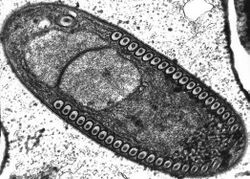Biology:Opisthosporidia
| "Opisthosporidia" | |
|---|---|

| |
| Sporoblast of Fibrillanosema crangonycis (Microsporidian) | |
| Scientific classification | |
| Domain: | Eukaryota |
| Clade: | Amorphea |
| Clade: | Obazoa |
| (unranked): | Opisthokonta |
| Clade: | Holomycota |
| (unranked): | Zoosporia |
| (unranked): | Opisthosporidia Karpov et al., 2014[1] |
| Groups included | |
| |
| Cladistically included but traditionally excluded taxa | |
| |
Opisthosporidia is a superphylum of intracellular parasites with amoeboid vegetative stage, defined as a common group of eukaryotic groups Microsporidia, Cryptomycota (also known as Rozellida, Rozellomycota, or Rozellosporidia) and Aphelidea.[1] They have been considered to represent a monophyletic lineage with shared ecological and structural features, being a sister clade of the Fungi.[1][2] Together with the Fungi they represent a sister clade of the Cristidiscoidea, together forming the Holomycota.
Several other basal groups of the freshwater, marine and soil-inhabiting Holomycota were identified in recent studies, as the 'basal clone group 1' (BCG1=NCLC1), 'basal clone group 2' (BCG2), 'basal marine group' (NAMAKO-37), 'basal group GS01', the inner relationships of Opisthosporidia were clarified and their monophyly questioned: Cryptomycota and Microsporidia were proposed to join the phylum Rozellomycota, while Aphelidea were considered as a separate, though related phylum and all these groups were considered basal lineages of the kingdom Fungi.[3][4][2][5]
Instead of probably paraphyletic Opisthosporidia, the phyla Rozellomycota and Aphelidiomycota (or monotypic subkingdoms Rozellomyceta and Aphelidiomyceta) are recently applied in some taxonomical systems of the kingdom Fungi for the basal lineages, and the other fungal lineages are grouped into a clade of True Fungi (Eumycota).[6] However, the taking up of the name Rozellomycota in such a broad sense can be considered premature, especially as the structure and biological features of a larger part of these organisms are unclear as they are known only from environmental sequences. The borders between Fungi and Protista are therefore unstable and final delimitation of taxa is problematic due to poor coverage of molecular data for the representatives of the basal groups.[6]
| Opisthokonts |
| |||||||||||||||||||||||||||||||||||||||||||||||||||||||||||||||||||||||||||||||||||||||||||||||||
References
- ↑ 1.0 1.1 1.2 Karpov, Sergey; Mamkaeva, Maria A.; Aleoshin, Vladimir; Nassonova, Elena; Lilje, Osu; Gleason, Frank H. (2014-01-01). "Morphology, phylogeny, and ecology of the aphelids (Aphelidea, Opisthokonta) and proposal for the new superphylum Opisthosporidia". Frontiers in Microbiology 5: 112. doi:10.3389/fmicb.2014.00112. PMID 24734027.
- ↑ 2.0 2.1 Torruella, Guifre; Grau-Bove, Xavier; Moreira, David; Karpov, Sergey A.; Burns, John; Sebe-Pedros, Arnau; Volcker, Eckhard; Lopez-Garcia, Purificacion (2018-05-25). "The transcriptome of Paraphelidium tribonemae illuminates the ancestry of Fungi and Opisthosporidia" (in en). bioRxiv: 233882. doi:10.1101/233882. https://www.biorxiv.org/content/early/2018/05/25/233882.
- ↑ Tedersoo, Leho; Bahram, Mohammad; Puusepp, Rasmus; Nilsson, R.Henrik; James, Timothy Y. (2017). "Novel soil-inhabiting clades fill gaps in the fungal tree of life" (in en). Microbiome 5 (42). doi:10.1186/s40168-017-0259-5. ISSN 2049-2618.
- ↑ Tedersoo, Leho; Sánchez-Ramírez, Santiago; Kõljalg, Urmas; Bahram, Mohammad; Döring, Markus; Schigel, Dmitry; May, Tom; Ryberg, Martin et al. (2018). "High-level classification of the Fungi and a tool for evolutionary ecological analyses" (in en). Fungal Diversity 90 (1): 135–159. doi:10.1007/s13225-018-0401-0. ISSN 1560-2745.
- ↑ Bass, David; Czech, Lucas; Williams, Bryony A. P.; Berney, Cédric; Dunthorn, Micah; Mahé, Frederic; Torruella, Guifré; Stentiford, Grant D. et al. (2018-04-28). "Clarifying the Relationships between Microsporidia and Cryptomycota" (in en). Journal of Eukaryotic Microbiology 65 (6): 773–782. doi:10.1111/jeu.12519. ISSN 1066-5234. PMID 29603494.
- ↑ 6.0 6.1 Wijayawardene, NN; Hyde, KD; Al-Ani, LKT; Tedersoo, L; Haelewaters, D; Rajeshkumar, KC; Zhao, RL (18 March 2020). "Outline of Fungi and fungus-like taxa". Mycosphere 11 (1: 8): 1060–1456. doi:10.5943/mycosphere/11/1/8. ISSN 2077-7019.
Wikidata ☰ Q20481166 entry
 |



